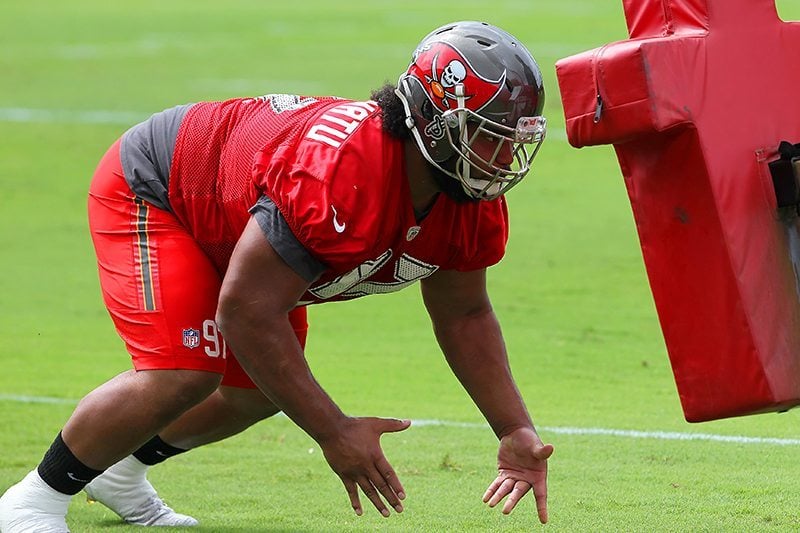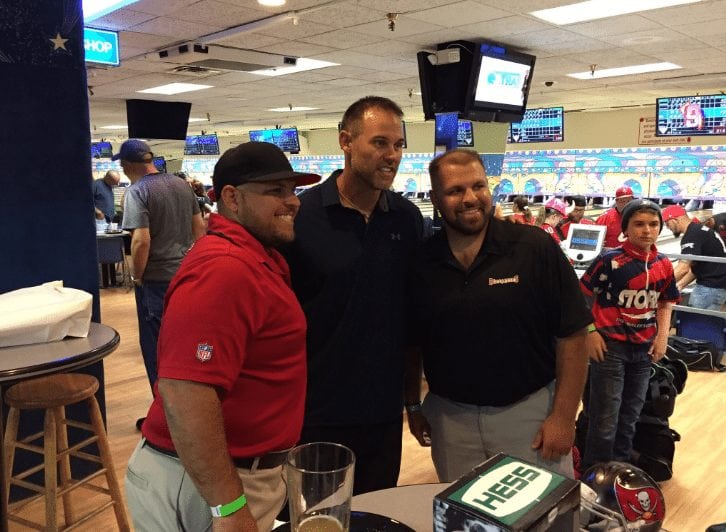Cover 3 is a weekly feature column written by PewterReport.com’s Tampa Bay Buccaneers beat writer Trevor Sikkema published every Tuesday. The column, as its name suggests, comes in three phases: a statistical observation, an in-depth film breakdown, and a “this or that” segment where the writer asks the reader to chose between two options.
Sikkema’s Stat of the Week
This week’s Cover 3 is more short and sweet than it is a novel of schematic breakdowns like I’ve published in the past – I can just hear the hallelujahs from Mark Cook as he reads this opening statement, since he’s always the one who has to edit my columns. Even though this one is easier to explain, it’s definitely something I wanted to make sure I touched on before we wrapped up our Cover 3 draft class series heading into training camp.
This week’s topic can be summed up in a playful phrase that I’ve been using for a few months now and that is: You can’t teach girth.
I started using this phrase when the Tampa Bay Buccaneers showed interest in, and eventually signed, defensive tackle, Chris Baker. Baker, at 6-foot-2 and well over 300 pounds, is not the typical defensive lineman the Bucs are used to prioritizing. But, by giving Baker the contract they did and signing him as early as they did, that appeared to be exactly what they were doing. Following Baker’s signing, the media asked the coaching staff, both head coach, Dirk Koetter, and defensive coordinator, Mike Smith, why this was the move over other players. Both explained that there was a need for this team to get bigger along the defensive front.
There’s a simple question that follows such an answer.
Why?
What’s the deal emphasizing such size? Does it really mater all that much? I mean, defensive linemen Gerald McCoy and Clinton McDonald were right around 300 pounds. Does it need to get much bigger? The short answer is yes, but in order to understand that yes, we need to know why size, in fact, matters along an NFL defensive front.
Stop The Run
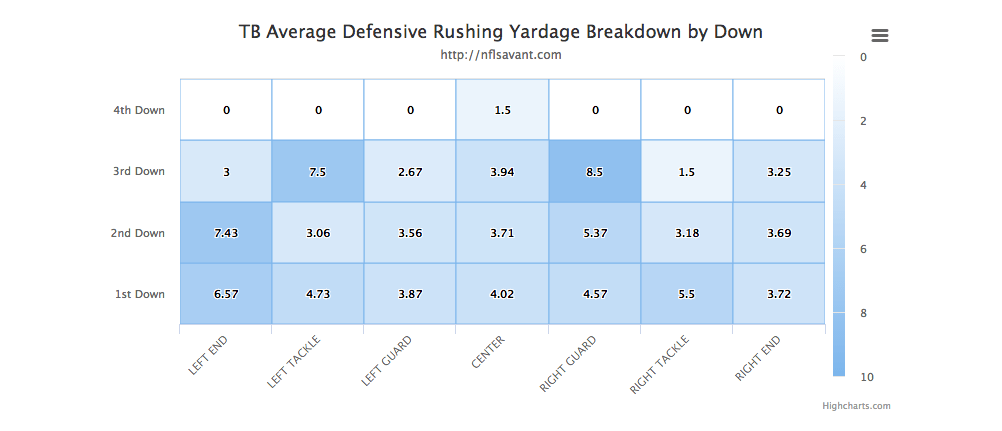
We read a lot about spread offenses and quarterbacks changing the game and breaking all sorts of passing records and how fast the game has become with the no huddle and spread game plans. That’s all great, and it makes the NFL a fun product, but none of that is possible, even in today’s NFL, if you can’t run the ball.
Running the ball is the No. 1 priority in football. Think about it, if you can get yards running he ball, what’s easier than just handing the ball to a guy and telling him to move forward? There’s no coverage to digest, no timing needed, no separation on a route, no pocket to form, no velocity to gauge. There’s just a snap, an exchange and the yards.
This is why stopping the run is still the top priority for a defense, and the most important down where a defense needs to make sure they shut down the run isn’t 2nd-and-6, it isn’t 3rd-and-2, it’s 1st-and-10. If a defense can’t contain an offense to less than three yards per carry on first down, it’s going to be a long day for them.
Think about it. Running the ball at an average of more than four yards per carry on first down means that an offense is in 2nd-and-6 or 2nd-and-5 almost at will. You don’t think offense’s in the NFL can pick up five yards in two tries, especially when, if they ran it again, chances are they’d get at least three more yards?
In the chart above – took you long enough to reference it, Trev – we see the Tampa Bay Buccaneers’ yards-per-run average from each of the downs during the 2016 season. As you can tell, those averages on first down are way too high.
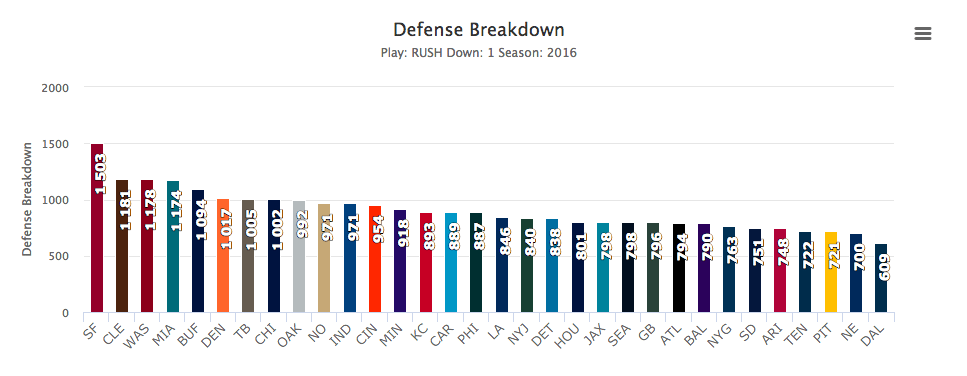
This next chart shows the total rushing yards gained on first down by each defense. The Buccaneers came in as the seventh-worst in this category, but it’s actually worse than that. Even though they were seventh in total yards, they had less first down run plays called against them than some of the teams lower on that chart. If you average things out, only San Francisco, Washington and Miami had worse averages in terms of rush yards given up on first down.
So how do you get better at that? Well, ideally you’d like to get more bodies in the box to overwhelm the offense and stop plays closer to the line of scrimmage. However, in today’s NFL where teams can have three wide receivers on the field and still run the ball, taking bodies at the second and secondary levels away from coverage, via substitute or what have you, would open up a defense to get gashed in the passing game – it’s a mismatch age.
The only other solution is the theme of the Buccaneers offseason: Get bigger up front.
Getting bigger up front allows a defense to do a few things – things that could go really far in Tampa Bay. The first is that it frees up the linebackers. When you have bigger players up front, chances are they’re going to be able to take on more than one block, therefore controlling the point of attack at the line of scrimmage. If the Buccaneers ever want to put themselves in a scenario where their defensive line is McCoy, Baker, McDonald and Gholston, that’s a lot of mass on the line of scrimmage. Chances are that group can take up all five offensive linemen, and that would allow for athletic, instinctual linebackers to track a ball carrier, rather than having to worry about plugging up holes. This is a much more advantageous approach for Tampa Bay because of the personnel they have at linebacker with Lavonte David and Kwon Alexander.
The second is a point I sort of alluded to in the paragraph above, but it’s creativity.
Throughout the offseason we’ve talked about the Buccaneers getting more creative on defense, mostly with their fronts as a team that could go either 3-4 or 4-3. We’ve gone into detail about what kind of players it takes to run each of those base formations, but with more size up front the team can even afford to get more creative (or ideal) in certain situations.
Three Safety Look
This is a question that has been asked of me recently, so I’ll explain it a bit here.
With more size up front, the Buccaneers would have the opportunity to play some three safety sets like the Patriots did last year where the third safety could have safety or corner responsibilities depending on the play. This would most likely be a role that rookie, Justin Evans, would assume if he progressed enough to get serious playing time this season. The Patriots had a lot of success doing this largely because they had the mass up front.
However, the team could also opt to play from a three safety look in a more unique manner. Something I saw in the Buccaneers mini camp was the team using a heavy front four with some sort of combination of McCoy, McDonald, Baker, Gholston or Ayers, then having Keith Tandy and Chris Conte as the main safeties, but using J.J. Wilcox as the nickel man up by the line of scrimmage, almost like a SAM linebacker only faster. If you have the size to take up most of the gaps already thanks to a bigger front four, you can get away with a cheeky move like using a big-bodied safety in a SAM spot who can also cover a running back out of the backfield better than a traditional, run-stopping linebacker – Bond has struggled in coverage from what I’ve seen.
46 Bear Front
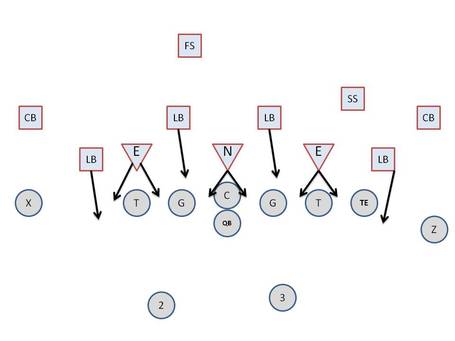
(via Buffalo Rumblings)
Finally let’s talk about a formation that is used for short yardage situations and that is the Bear Front or the 46 defense. The 46 defense is a defense that involves a heavy front four, three or four linebackers that know how to stop the run and a strong safety in the box as well. The name of the 46 (and why it’s called the “Bear” front) comes from when Bears’ defensive coordinator, Buddy Ryan, created the formation and emphasized strong safety, Doug Plank, who wore the No. 46.
The graphic above shows a traditional 46 defense. It comes from the 3-4 defensive front family where there is one nose tackle and two defensive ends. But, as the NFL has evolved, so has the Bear front.
This is what it looks like today.
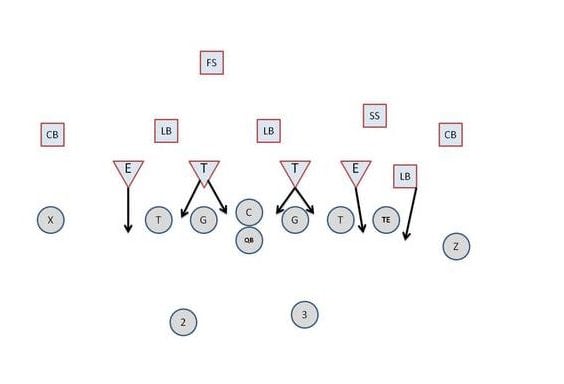
(via Buffalo Rumblings)
The above formation is much more suited to what the Buccaneers would like to run but have never really had the personnel top do so. In it, instead of one massive defensive tackle, you’ll have two. These are the roles that can now be played by Baker and say Stevie Tu’ikolovatu or Sealver Siliga. Then, you can have McCoy playing as the strong side defensive end with Gholston as the weak side defensive end. This would allow the SAM linebacker to also help at the line of scrimmage and would fully free up the two linebackers, Alexander and David, to be instinct-based rather than gap stuffers, even in short yardage situation.
The NFL is a bully league; the big man wins. The more size you have in the trenches – especially if they’re players with size, strength and can move well – the more freedom you have to let the other athletes on the defense do what they do best. The less bodies you need to control the line of scrimmage and stop the run, the better your coverage will be, and the more creative you can be in what players you send out there with different responsibilities.
When defensive coordinator Smith talked about getting more versatile and creative on the defensive side of the ball, the first step to that was getting bigger up front. Now you know why.

